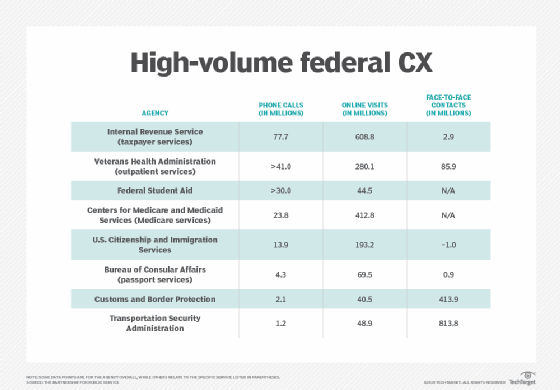
peshkova - Fotolia
Public sector's customer experience strategies analyzed, ranked
Some U.S. government agencies use technology to earn high marks for CX. Others need improvement in areas that corporate marketing teams can learn from.
In general, private sector CX is ahead of its public sector counterparts in the U.S. government, which drives citizen expectations of the level of service they demand from their tax dollars, according to a report issued by the nonprofit Partnership for Public Service in conjunction with Accenture's federal IT consulting group.
But the report's authors uncovered trends in examining millions of government customer engagements that can be applied to customer experience strategies, whether in the public or private sector.
The report found that some U.S. government CX teams use technology well to improve citizen services and build a positive brand, despite obstacles. Other agencies don't fare as well, according to the report, based on September 2019 data published by the Office of Management and Budget's CX improvement team.
Take the Transportation Security Administration (TSA), whose airport security screening lines sometimes delay travel. TSA mitigates some of the negative backlash by talking directly with passengers on social media -- with a little humor -- to answer questions about what personal items can delay the screening process.
The agency also does a good job of administering and managing programs such as Global Entry and PreCheck, which expedite the screening process, the report said.
Passport Services, which issued 21 million passports in fiscal year 2018, scores lower in customer experience because the agency doesn't have an online application process; it requires that travelers apply in person.

Don't make CX a 'black box'
TSA earned high government customer experience marks on the report, even though it doesn't count customer experience as an agency goal or measure its CX performance. Some agencies that make customer experience a higher priority scored lower.
The U.S. Citizenship and Immigration Services (USCIS), which manages work permits, as well as health insurer Medicare, got lower grades than TSA in the report. Those agencies' websites sometimes make customers feel as if they are interacting with an unresponsive black box and can wait months to hear back after applying for services.
When citizens get frustrated or confused, they visit government agency field offices or call an agency contact center. That experience typically gets a favorable customer response, but costs skyrocket: For example, the IRS estimated it costs the agency $41 to field a phone call and $67 per office visit.
These problems can be solved with better websites and mobile apps that offer faster, more detailed responses, said Kathy Conrad, director of digital government at Accenture Federal Services.
"Instead of having people only being able to call to check the status of their benefit application, a loan application or their tax refund, providing a self-service online tool like a widget on a website or a mobile app delivers a far better customer experience," she said.
Data drives customer experience strategies
Whether in the public or private sector, a good customer experience hinges on finding out what the customers want first. Then, making them happen.
The Veterans Health Administration (VHA), the largest integrated healthcare system in the United States with more than 1,200 facilities, established the Veterans Experience Office in 2015 to improve CX after widely reported long wait times. Its labyrinthine websites made it difficult for military veterans in need of healthcare to find information.
VHA launched new services such as same-day emergency mental health care and added guides to VHA hospitals to help patients find their provider quickly. Those and other actions improved veterans' perceptions of service quality.
On the technology side, the VHA reorganized information on websites with a new interface and consolidated hundreds of sites into a unified homepage. That, along with faster response times to phone calls and social media posts, improved satisfaction scores.
The VHA also did what Passport Services hasn't yet: It made online versions of frequently used transactions. Veterans can apply for care, schedule an appointment, view lab and test results, and manage prescriptions via the web.
Public data collection efforts hindered
Many of the improvements the Partnership for Public Service observed at government agencies came from qualitative research of customer interview and survey data. That forms the bedrock of customer experience strategies, in which an entity discovers and delivers what the customer wants.
"One of the things that's really important and applicable to the private sector is good customer research," said Eric Keller, senior manager at Partnership for Public Service. "Measure what's important to your customer rather than measuring things that are important to them internally."
But government customer experience teams are limited in their ability to collect Voice of the Customer data in one key way that the private sector is not. The Paperwork Reduction Act requires agencies to complete an extensive Office of Management and Budget (OMB) approval process before collecting information from 10 or more members of the public.
While OMB has instituted a fast-track approval for agencies to collect survey data and interview more than 10 people at a time, little of it can be made public. A proposed law, the Federal Agency Customer Experience (FACE) Act, aims to end those restrictions to agencies' qualitative CX research.






